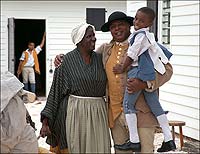Page content
The African American Family

Most of Virginia’s slave population came from West Africa where kinship was at every level of society. Each person was a member of a people, a clan, a family, and a household. The people had a common language, the clan a common ancestor. The family was extended to include grandparents, aunts and uncles, cousins, and other relatives that wanted to be part. The household was the smallest unit – usually mother, father, children, and maybe, but not always, grandparents.
West African wives were subordinate to their husbands, but it was less strict in practice than the European patriarchy. For the children, grandparents and older aunts and uncles passed on family and clan history and traditional lore, and education was a group activity. A modern West African adage is, “It takes a village to raise a child,” which is simply a recognition of how it used to be done.
West African kinship was both horizontal and vertical, horizontally to everyone in the village, vertically to ancestors long dead and children not yet born. An individual’s life got its meaning from unity with a common existence. Kin were living, dead, and unborn.
Coming from West Africa
A West African transported in a slave ship to anywhere in the New World had everything in his or her life destroyed. What he or she had to do was build a new kinship in a new and strange land and a new and strange society. How much of what they built in this new place was African origin, how much European, and how much Indian is debated by historians. It is certain, however, that the kinship they knew in West Africa did not exist in Virginia.
Enslaved Families
Efforts by 17th century Africans to form families initially suffered from the same high death rates that confronted early Europeans. But while the ratio of men to women in Virginia among Europeans might have been as high as three to one, among Africans it might have been half that or less. There were other difficulties. Slaves could not travel freely to find mates. African women had unusually low birth rates, perhaps from the trauma of enslavement and the Middle Passage, perhaps from the traditionally longer nursing periods among Africans that prompted sexual abstinence, or perhaps because they did not want to bring children into the world in slavery.
By the second quarter of the 18th century, the enslaved population in Virginia began to reproduce in greater numbers. Virginia-born black women had a higher birthrate than their African mothers and they had their first child earlier. Plantations may have had larger slave populations and, perhaps, a more stable family life.
The concept of stability for slave families was temporary, at best. The legal and religious institutions that supported stability for white families were indifferent or even hostile to stability for slave families. Slave marriages were not recognized by law or the official church, so if some difficulty or desire among whites made it necessary to sell or rent slaves, there was nothing to prevent the break-up of a slave family.
Despite the obstacles and uncertainties, black men and women were married in ceremonies outside the church that combined European and African traditions. Husbands and wives owned by different masters sometimes traveled long distances at night on foot trails to visit. Night walking, a tradition born of necessity, helped hold the slave family together.
Interdependence
Slaves depended on their masters for food, shelter, clothing, and health care. The masters depended on their slaves for labor and services, and that led to a complex relationship of authority, obligation, and family loyalty that must have required diplomacy and skill to negotiate. Field hands and domestic servants had different problems. Domestic servants might get cast-off clothing and other gifts, but field hands traditionally got Sundays off, which the domestics did not. In the same way, rural slaves of any kind had different problems than town slaves, who had an easier time finding mates and doing odd jobs to earn tips.
But on plantations or in towns, the close proximity increased the influence that black and white families had on each other. Children of both families played with each other until they were ten or so, and teenaged black girls provided childcare in white families. To one degree or another, blacks and whites influenced each other’s living spaces, work rhythms, childrearing, speech patterns, and religious beliefs.
Content excerpted from the Colonial Williamsburg Foundation’s publication “Becoming Americans”.